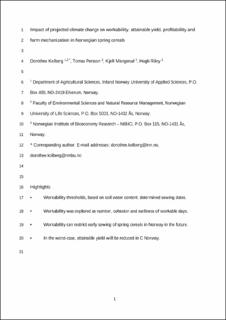| dc.description.abstract | In cold-temperate climate with high soil water content in spring, the farmer often faces the choice between topsoil compaction during seedbed preparation and delayed sowing, both of which may reduce attainable cereal yield. The objective of this study was to explore whether future climate change with increasing precipitation would aggravate this dilemma. We generated weather based on historical and projected future climate in Southeastern and Central Norway. Using this weather data as input, we simulated spring workability, attainable yield, timeliness costs, and mechanization management with a workability model and a mechanization model. The projected climate changes resulted in improved workability for spring fieldwork and higher attainable yield in South-eastern Norway, and either positive or negative changes in Central Norway compared to historical conditions. We observed a general increase in variability of workability and attainable yield, and a larger risk of extremely unfavourable years in the most unfavourable scenarios in Central Norway. Changes in profitability and mechanization management were small, but followed the same pattern. The negative effects in the most unfavourable climate scenarios in Central Norway were in contrast to positive effects in earlier studies. We explained discrepancies by differences in research methods and purpose. However, simulated sowing dates of annual crops should consider workability of the soil, in terms of water content. Under worst-case conditions, in need of a certain time window to complete their spring fieldwork, farmers might adapt to impaired spring workability by working the soil at higher water content than simulated in our study. The consequence would be a larger loss of attainable yield and less profitability in the future. We anticipate that negative effects may also be expected in other northern cold-temperate regions with high soil water content in spring. | |
